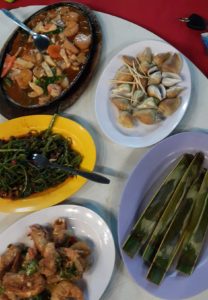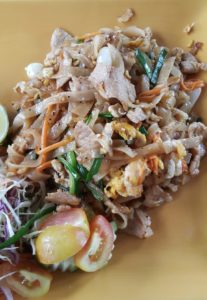Do you like Thai food?
Every culture has its own distinct cuisine, and there is nothing of which the Thais are more proud than their food, and rightly so. My initiation was of course the (in)famous Khao Man Gai, and it is for all intents and purposes a good stand-by if you really can’t find anything else or are just being totally unimaginative, but there are thousands of other dishes to choose from. The thing you have to get used to, however, is the different levels of spiciness involved in each different item, and then, of course, the taste the cook prefers, and so you can go to 50 different restaurants, order the same dish and get 50 different versions of it. But for any newbie to this country, if you’re going to be spending any amount of time in any particular place and get to know the people, you’ll be put to the test on all kinds of things.
My worst horror story of course was the field rats and the odd cobra dish, but for some others, the test is much more severe, ranging from bugs that look like deep-fried cockroaches, to deep fried grasshoppers, red ant eggs, a certain type of wood worm known locally as the ‘rod fai duan’, and chicken claws. Then there are all the different types of chilli paste, more than 100 of them in all, with some of the more delicious making use of some dubious ingredients, but if you want the best ones, the recipes are likely from more than a century ago.
Fiery Ingredient from the Americas
The introduction of chili peppers to the country by the Portuguese (yes, chilies are not native to Thailand, they came from south America) resulted in an entirely new twist to local cuisine. I haven’t found any texts on the first introduction of these ‘hidden’ bombs to Thailand, but the fruits of that introduction can be seen in some of the most famous restaurants in capitals around the world. Within Thailand itself, you can barely walk anywhere without running across some type of food stall, whether it be noodles, slimy-chicken khao man gai, a variety of pork leg dishes, fresh seafood, or just a host of curry dishes. Of all these, one of my favourite noodle dishes is a northern Thai specialty, Khao Soi, which is a blend between a curry and a noodle dish, with either chicken or beef. In some instances you might almost consider this dish to be beef stew with noodles, thick and juicy, with lots of ‘gati’ or coconut milk. Some of the best restaurants are (and the best way to find them) the places where the taxi drivers stop and eat. Where there are a lot of taxis parked outside, the food is guaranteed to be good, and not very expensive. While some of the worst places to find Thai food are restaurants abroad which claim to offer Thai food, but are erstwhile Chinese restaurants turned into Thai restaurants, or places that have toned down their ‘taste’ to suit the palates of the undiscerning and uninitiated.
One of my closest friends was a Thai food critic, and with him I discovered and explored some of the best places for Thai food in the country, but as far as seafood goes, I still enjoy the open-air shop in the middle of China town right next to the main road – exhaust, soot, and whatever else, it still is the tastiest place.
Regional diversity
Of course, each region of the country has its own distinct cuisine, with the north offering something a little sweeter and softer, the central region offering a mixture of things, including some Chinese adaptations, the northeast offering the most intriguing types of dishes with its fermented fish, a host of indescribable ingredients and its masterpiece, papaya salad, while the southern region is probably host to the spiciest food available in the country. Yet despite the wonders of this internationally praised cuisine I am still not totally enamoured of Thai cuisine, having grown up and being fed bread and potatoes, but when it comes to meals with friends, I do enjoy the variety of dishes offered, and much prefer that type of setting over single dishes.
For any visitor coming from a cuisine-challenged country, however, (including just about every country in Europe; yes, France as well), it takes a while to get used to the local eating idiosyncrasies. Although meal times are regular (breakfast, lunch, dinner), there are all the little things in between the main meals that give the impression that the entire day just seems to be one continuous buffet. A bowl of noodles, then some rice, then some snacks of this or the other thing, then more noodles or a ‘real’ meal, then more snacks; often enough during the day your nose is tweaked or irked by the scent of something or another being consumed at the desk next to yours.
Timing is everything – ulcers and mealtimes
The constant ‘nibbling’ during the day has another consequence, one that drives me absolutely crazy. Regardless of the years I have spent living here, I have maintained a certain way of eating that depends on three main meals with very little or nothing in between. A solid breakfast is followed by a decent lunch (if possible and time allows), and a healthy dinner. There are times when I get so busy with something that I will forget that it is lunchtime, and even if at 2pm I start to feel slightly hungry, I will look at how much longer the task will take, and decide whether or not stopping at that time for a meal is a good way to go, or to continue on for another 30 minutes or an hour to complete whatever it is I am doing. An example of this would be a drive, for instance, from Bangkok to Chiang Mai. A trip such as this usually takes between 6 – 7 hours (the way I drive). Starting out after breakfast at about 6 am, expected time of arrival is sometime between noon and 1pm – maybe 1.30pm depending on conditions. A break at around 9.30 or 10 allows for some food and snacks, a drink or two, and maybe something bought for later on. I am fine to go the entire trip with a single pit stop or two for a bottle of water, a coffee, maybe an apple or an orange. I have set my mind on the arrival time, and have already thought about a decent place to enjoy a nice relaxing lunch after the long drive. But I have forgotten to take into consideration the needs of my fellow passenger(s).
The clock slowly inches its way to the noon hour. We’ve been making good time. For sure we will reach the destination no later than 1pm. Yet suddenly there is a sigh from the passenger seat, followed by a moment of silence, then another sigh and a search around the car interior for something to eat. Bags of snack foods are held up before they are tossed back on the back seat. Another sigh or two. I quietly hold my breath and pray that I am wrong, even though I know I am right. “I want to eat something, but I don’t know what. A bit hungry.” … I consider this comment, study it from all its various angles, and truly cannot come up with a proper reply. The obvious thing would be to suggest eating any one of the snacks, but that would be met with a scornful look. Hunger is not stilled by snack foods. A few minutes of silence follow, and I hope that the topic is forgotten, but that bloody clock keeps ticking, and it is now five minutes to noon. Another sigh and a shift in position. “I am hungry.” The statement is indisputable. A truth. A fact. A mathematical certainty. Thoughts of a nice meal at a good restaurant in a beautiful setting on the river evaporate. I make a vain attempt: “we’re almost there. Another hour. The restaurant, remember the one on the river? I was thinking we could have lunch there, relax, and let me rest after the long drive…” There is a shifting of the body, but also one of attitude, and I know that I have lost. “We should stop, I can feel my stomach cramping. If I don’t eat something soon I will get ulcers. That’s what the doctors always say, not eating at the same time every day will give you stomach ulcers.”
Who’s going to argue with the medical profession. I search for signs along the highway, and secretly hope that there aren’t any, and try to press on. Time slips by, and it’ll be another 30 – 40 minutes or so before we reach the destination. “Ohhhh my stomach hurts. I think I am getting an ulcer.” There is nothing for it but to stop and have a bowl of noodles. Grudgingly I slurp down the noodles, the vision of a nice lunch slowly fading away like a mirage. A half-hour later we are back on the road, I am not full, and make the comment that we could still enjoy a late lunch at the restaurant, a beer perhaps, and relax. But I know even before I finish my sentence that lunch is well and truly over. A look of incredulity is directed my way. “Why would you want to eat again, we just had lunch. I am not hungry.”






